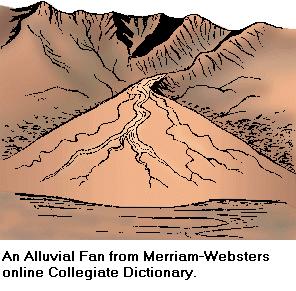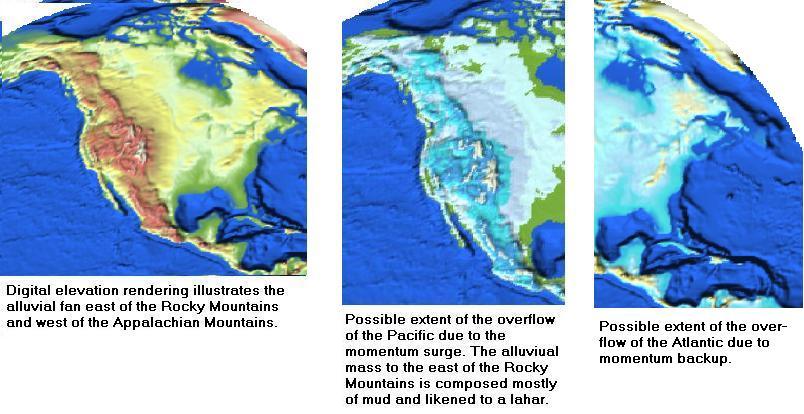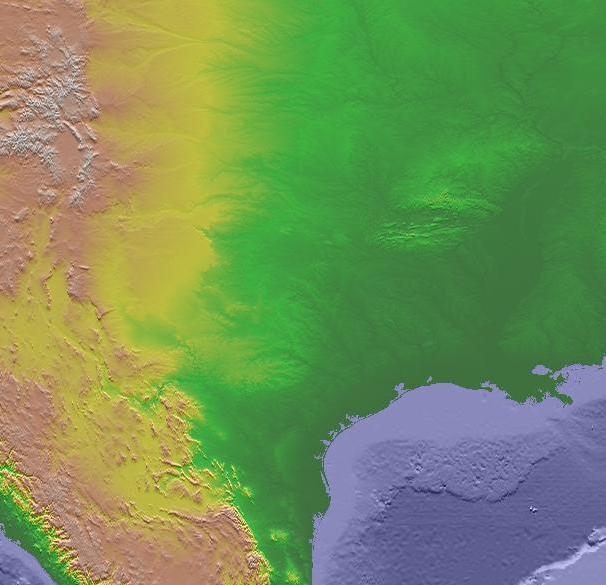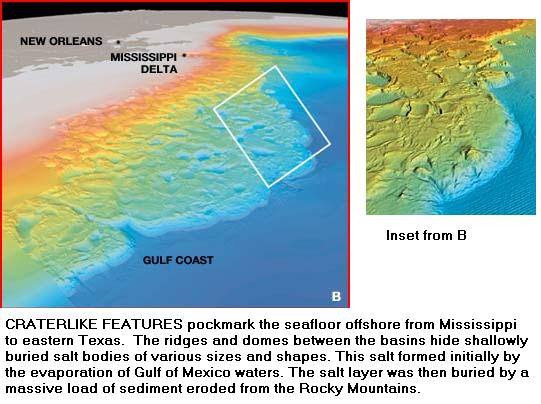|
Alluvium and Alluvial Fans
Alluvium is clay, silt, sand, gravel, or similar detrital material deposited by running water. Geologists look for alluvial fans as evidence of a flood. Alluvium is first deposited by a large movement of water, such as would occur during a flood, which then shows erosion through the action of smaller streams. Most alluvial fans look like mud slides from mountainous elevations. Below is a drawing of a small alluvial fan where it issues from a gorge onto a plain and a tributary stream or streams are in the process of eroding smaller amounts of material from the larger flow.

In previous sections we have identified potential causes for continental floods that could have swept over the mountains. Indeed, Native American legends thoughout the new world make this claim. The cause has been identified as a momentum overflow of the ocean basins due to the impact of a large comet that both accelerated the spin of the Earth and caused the Earth to roll as a consequence of gyroscopic precession. We determined the overflows or floods would first have come from the southeast as the momentum of the water backed up. Then there would have been a surge to the northeast as the momentum of the water caught up with the motion of the solid earth. This is due to the motion of the Earth increasing rotational spin to the east, and rolling to the south. It would be like filling a shallow bowl with water, placing it on a table and moving it sharply in a particular direction. The water overflows first against the direction of the motion, and then with the direction. It is easy to prove this is true by performing the experiment.
If, indeed the motion of the Earth changed as has been hypothesized, and flood waters flowed over mountains, then there should be a great deal of evidence in the form of alluvial fans. We should also expect alluvial fans extending from mountainous regions near the Atlantic coast of North America to be largely on the western slopes and extending to the northwest as a result of the flow. In the western mountains we should observe alluvial fans east of the mountains with a flow direction to the northeast. In fact, due to the magic of digital elevation modeling, this is exactly what can be observed.
| Sometimes alluvial fans are too large to see. |

|
Water borne sediments also form Fans under the oceans along coastal waters. Below is a digital rendering detailing Aluvial Fans east of the Rocky Mountains and into the Gulf of Mexico.
| From the Rocky Mountains to the Gulf Coast |

|
| Note how the Mississippi River has eroded the fan |
Massive amounts of Rocky Mountain sludge flowed into the Gulf of Mexico basin, from Texas to Mississippi and covered a layer of salt Halites that existed there. The salt is now bubbling through creating craters in the Fan, which are known a diapirs. One can only wonder what the nature of the Gulf of Mexico was before this slide occurred, that it would have an undisolved layer of salt. One can only guess the water level in the Gulf was not what it is today. The images below are courtesy of Scientific American, June 1997.
| Another view of the Gulf of Mexico undersea Fan |

|
How do Salmon fit into the Flood picture? Salmon are anadromous fish. This means Salmon ascend into freshwater rivers and streams to mate and breed offspring, while spending most of their adult lives in saltwater oceans. Salmon are thought to possess an organ, upon which minerals are deposited throughout their lifetimes and by sensing the minerals are able to compare the composition of water and trace their journey from the oceans to the fresh water rivers and streams where they were spawned. This is sometimes called a homing instinct. They always return to where they were spawned to mate and breed future generations; even if it requires swimming hundreds of miles, upstream to the high mountains to do so.
Since Salmon swim to their spawning grounds to mate and reproduce, what force or phenomena could have been responsible to initiate the original spawning in fresh water high mountain streams? Adult Salmon would never swim there to mate, if they had spawned elsewhere and indeed, this is shown to be the case when Salmon are artificially spawned in shallow tidewater pools along the ocean. The Salmon spawned in these pools return to those pools to mate and don't bother swimming to the fresh water high country as so many of their brethren do. This rules out the possibility that ocean born adult Salmon for some reason left their ocean habitat to propagate in freshwaters originally. It only leaves the possibility that Salmon eggs were first placed in fresh water streams, there to be born, before their migration to the sea. Adult Salmon did not do the original placing, because they would not have been born there.
| Listen to the Salmon. They speak only truth. |

|
Indigenous native Atlantic Salmon return to streams and rivers to breed from Connecticut to North Labrador, as far inland as Lake Superior drainage. On the other side of the Atlantic, Salmon still return to fresh water to breed in Britain, Ireland and areas of the European mainland. Indigenous native Pacific Salmon return to streams and rivers to breed from Central California to the Bering Straits, as far inland as the continental divide.
The only phenomena that could reasonably place Salmon eggs in such a broad distribution would be a continental flood. Common sense would dictate that the momentum backup and surge overflows of the waters of the Atlantic and Pacific Oceans contained millions and millions of Salmon eggs, which were dropped on the shores in what, became rivers and streams. There they hatched, and made their way to the sea, where they spent their adult lives. Then, obeying their instinct to return to their spawning grounds to mate they swam up the fresh water rivers to begin the cycle we observe today. It was the flood that began this cycle.
|



